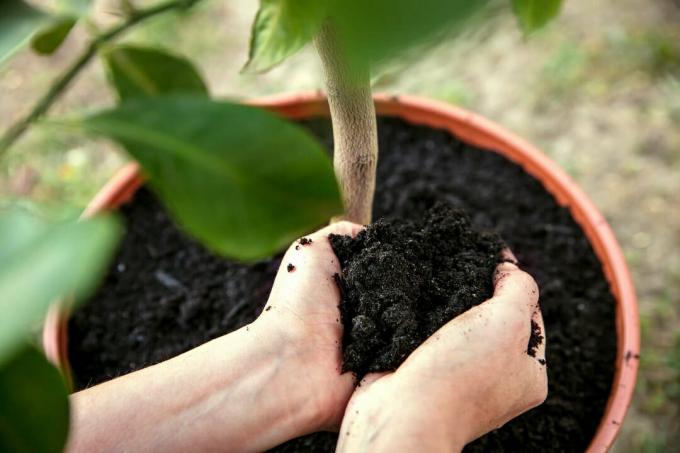Lemon trees are mainly planted in pots. Here's how and when to repot your lemon tree.

The cold-sensitive lemon tree (citrus x lemon) is mostly cultivated in pots in our latitudes. In the ground, trees typically develop a dense, sprawling network of roots about the size of their crown. No wonder, then, that a potted lemon tree quickly reaches the limits of its pot.
When repotting, not only is the pot or tub enlarged by one level, giving the roots more space. The fresh, nutrient-rich potting soil that gets into the pot in this way is also particularly important for the lemon. Regular repotting is therefore an important measure to create new space for the roots and to ensure the supply of nutrients.
"Contents"
- When do you repot lemon trees?
- Repot lemon tree: instructions
- Repotting a lemon tree: Which soil is best?
When do you repot lemon trees?
Young lemons are vigorous and should be given a new container and fresh soil every year up to the age of five. With increasing age, however, it is not necessary to move the tree to a new pot every year. Older, weaker lemon trees should only be transplanted every two to three years if the existing substrate has been completely rooted. The right time to repot the lemon tree is in spring. From March to April, repot your lemons in the winter quarters, as this is when the Mediterranean plant begins to grow. At this time, the tree gradually awakens from its hibernation and the supply of nutrients from fresh potting soil supports the formation of leaves and flowers.
tip: The lemon tree should only be placed outside unprotected from mid-May. Before that, spring temperatures are too cool and there is a risk of late frost.

Repot lemon tree: instructions
Repotting lemons is not complicated and can be done quickly. When choosing the pot, you should note that clay pots store moisture better, but the larger they get, the more difficult they are to handle. A pot made of lightweight plastic is therefore a good alternative for heavy, old lemon trees, even if the clay does not retain water. But which pot size should you choose for repotting?
Basically, it is important that the lemon gets a pot that is a third larger than the root ball. There should be a hand’s breadth between the pot wall and the roots on all sides. Above all, it is crucial that the tree is not placed deeper than in the previous vessel. The pot should also have good drainage. A drainage layer of expanded clay, sand or gravel about 5 cm high at the bottom of the pot also improves water drainage and prevents waterlogging.
Repot lemon tree - step by step:
- Choose a larger, new pot with good drainage.
- Fill in a 5 cm high drainage layer of gravel, expanded clay or sand and add a hand's breadth of fresh potting soil.
- The root ball is carefully freed from the old planter.
- Loosen up the root ball with your fingers. Soil that is not rooted is allowed to fall away. Damaged or diseased roots are cut out.
- The root ball is placed in the middle of the new pot. Fill in the gaps with fresh substrate and press lightly all around.
- Finally, the lemon is watered.

Repotting a lemon tree: Which soil is best?
The easiest way to get a suitable substrate for your lemon tree is to buy special citrus soil. Good substrate for citrus plants can also be easily mixed by yourself. A high-quality potting soil, like ours Plantura organic universal soil, contains essential nutrients and promotes root growth due to the high compost content. To increase water permeability, you will also need sand, perlite, expanded clay or clay granules. Mix the two components in a ratio of approximately 2:1.
After repotting the lemon tree, you should carry out the first fertilization about four to six weeks later. After this time, the lemon has established itself in the new pot and has already formed fresh roots. A primarily organic liquid fertilizer like ours Plantura Organic Citrus & Mediterranean Fertilizer, can be easily spread over the irrigation water. Fertilize your lemon trees about once a week through September to keep them well-nourished.
tip: If the lemon tree has not been repotted, you should always wait until the leaves have sprout with the first fertilization.
In spring, in addition to the budding, the lemon will soon start flowering and fruiting. A good supply of nutrients is particularly important during this time for healthy plants and a rich harvest. More tips on how to Fertilize lemon tree should be found in our special article.



